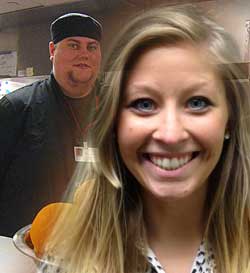
Behind every successful operation is an entire team of people, and the kitchen and cafeteria at Pomegranate is no exception. Facilities Director John Hedrick explained, ‘Our food is not institutional here. Don’t think prisons or cafeteria. It’s restaurant quality. We are balancing healthcare considerations with food that appeals to teens. Those might seem like conflicting demands.’ Pomegranate surveys its teen residents on an ongoing basis on a number of quality measures, food among them. Everyone has an opinion; and ‘food’ is not a neutral topic. We went to Registered Dietician, Shelby, of Dietary Solutions, and Pomegranate’s Chef Bart for answers.
How does Pomegranate decide what to serve residents?
“There are many factors we consider when writing the menus. It has to look good, taste good, be healthy and nutritious, be cost effective and on top of all that, something the kids will actually eat,” explained Chef Bart. “Some teens have specific needs or allergies which must be taken into account,” added RD, Shelby.
Are there options?
“Any kid that does not like/want whatever we are having for a particular meal has the option of ordering a substitute,” said Bart.
What are some of the considerations a registered dietician must take into account?
“I look at overall calories, activity, age, gender, vitamins & minerals, sodium, carbs, sugar, fat, basic food groups, fresh, healthy foods, and balance,” said Shelby. Shelby then gives Chef Bart written recommendations for kids as needed. He writes those recommendations on a dry erase board in the kitchen to communicate to all dietary staff so they know what to do.

Residents have input into what is chosen. How does that work?
“Every month the Resident Senate meets. I get together with one representative from each unit and we discuss what they like about the menu and what things they would like to change,” explained Chef Bart.
What are some of the favorite meals?
“The kids really enjoy the things all kids like. Things like pizza, chicken, and mac & cheese. One of the favorites is what we call Hot Cheeto Chicken, which are chicken tenders that we bread in-house with crushed Flamin’ Hot Cheetos in the mix. It’s definitely the thing I get asked, ‘When are we having that again?” the most,” he added.
Does popularity of particular foods change?
“Yes, if we have a particular item too much the kids get tired of it. Also tastes change with the seasons. Now that we are in the spring season, it’s time for lighter, more fresh options as the produce becomes readily available,” he said.
What has changed since Pomegranate started in 2008?
‘Well I haven’t been here since the beginning, but I have been with Pomegranate for over five years. I’d say the biggest change is the number of kids. With the expansion last year and all the beds they added, it sure keeps us busy. Teens go to the cafeteria in small extended family size groups by campus. It is a symphony of scheduling by walkie-talkie. There isn’t any overlap or a huge school cafeteria feel,’ he said.
What have been some learning experiences?
“I have really learned the difference between the tastes of kids and adults. I am a classically trained chef with a fine dining background but that doesn’t matter if the kids won’t eat what I’m cooking. I have learned little techniques to invite the kids to try new things, like our wording on the menus or by pairing something they are reluctant to try with something they really like. The biggest thing is getting them to try it,” Chef Bart suggested. “They usually say, “Hey this is actually good!”’, added Shelby
What have been some high points for you along the way (makes your job rewarding)?
“Although I’m not around the kids as much as the direct care staff, I still enjoy getting to know them. Telling them, “Good job!” as they reach a goal. (Discharge, Graduation) Making something that they really like and then having a kid come tell you it was the best thing they ever ate; that’s why I do it, he said with a smile.
Anything else our readers might want to know; a ‘did you know . . . ?
“I am very proud to be leading dietary staff here at Pomegranate. We have five full time cooks, two dishwashers and a couple of utility workers, and between us we put out three meals and three snacks 365 days a year, for residents and staff members. And that’s not including special events, meetings and parties that we cater.”









